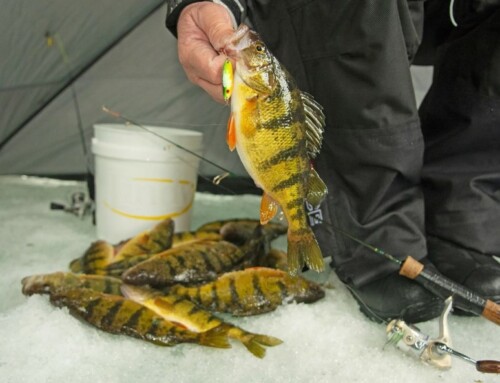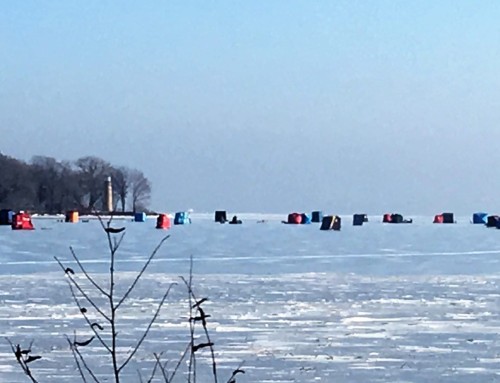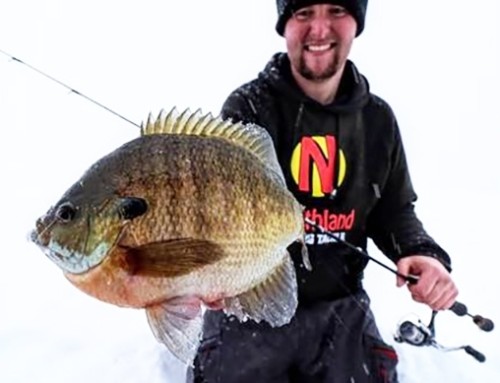CAPTAIN PAT KALMERTON, ON MICRO-TUNED FINESSE PRESENTATIONS FOR SHALLOW-WATER PANFISH
Plano, IL (January 26, 2017) – “I do it for the challenge.”
The USCG-licensed captain and guide, Pat Kalmerton, was explaining why he travels across the country to ice fish. As owner of the busy, all-outdoor, Wolf Pack Adventures Guide Service headquartered in Sheboygan, Wisconsin, Kalmerton doesn’t lack ice time. Yet, on his days off, he travels to new and previously unexplored ice fisheries as if provoked or dared.
To say the 36-year old is bitten by the outdoors bug is a supreme understatement. When he’s not on the water or the ice, Kalmerton can be found chasing bucks and turkeys all over the Midwest, and ducks and geese wherever they fly. So, it’s probably no surprise he’s on the ice from freeze through thaw.
Inches matter in this Wisconsin pro’s finesse formula for shallow-water panfish. Sub-8”-holes don’t cut it for Kalmerton.
Decidedly burly and borderline gruff in appearance, the highly approachable Kalmerton is, in fact, a social teddy bear and angling savant who makes new friends fast wherever he goes. “I’ve learned ice fishing tricks from different people in all different scenarios,” Kalmerton explained. “And they’ve greatly improved my own fishing experiences and efficiency here in Wisconsin.”
While Kalmerton has caught just about every fish that swims beneath the ice, it’s panfish that occupy the lion’s share of his oversized man-heart . “I love the hole hopping aspect and the different ways they hit. It’s always a challenge; every day is a different bite,” he said.
Kalmerton has taken the game of shallow-water panfish to new levels through his tireless pursuit of maximum finesse. His method can be defined as micro-tuning, and it comes from necessity. “Shallow water equals green weeds, which equal microorganisms,” Kalmerton explained. “It’s an active feeding scenario; fish are feeding because there’s lots of food flying around… bugs and plankton.”
Kalmerton went on to explain that, although shallow fish are often feeding fish, they can still be quite difficult to catch due to the lack of depth and the diminutive nature of what they’re feeding on. In other words, effectively mimicking plankton is no piece of cake. And targeting the largest fish across heavily fished waters creates additional challenges.
Ice Hunter Pat Kalmerton is equally as effective pinning predators to the ice.
An exacting tackle system, fished with proven methods and maximum mobility, provides the basis for Kalmerton’s micro-tuning methodology. Even when on a hot bite, Kalmerton moves every 5-6 fish, breaking the most basic of angling codes and leaving fish to find more. His reason is simple: “You catch the big fish first.” But there’s more to it than that.
Kalmerton went on to explain that, in order to initially fool the largest fish in the school, an unorthodox approach is required. “Most people lower their bait all the way to the bottom on their first drop; that’s wrong. It’s best to lower your bait and hold it above the school of fish – say five feet down in eight feet of water. The biggest fish in the school will often shoot up and get the bait.” It makes sense, as larger fish are naturally able to out-swim other members of the school.
In addition, Kalmerton insists that nothing else goes down the hole when fishing shallow – no depth checkers, cameras… nothing – before he drops a bait. He even resists the use of sonar to avoid the fish feeling a signal.
But Kalmerton’s finesse approach goes far beyond the rules of what goes down the hole and when.
Perhaps the most intriguing of his methods is one he calls walking a jig. Here, Kalmerton baits a small, dense jighead with a long, thin plastic tail and crawls it across the bottom to imitate a blood worm. In Kalmerton’s walking game, inches matter. So exact is this procedure, Kalmerton distinguishes crawling distances in inches of bottom covered, and demands no smaller than an eight-inch diameter hole to optimize the presentation.
Kalmerton’s go-to finesse panfish rod is his namesake Frabill Model 678001 Pat Kalmerton 26” UL Panfish Ice Hunter Combo – a rod he modeled after his former favorite 24” rod, while adding extra length to perfectly support his jig walking and other unique, micro-tuned panfish presentations.
Such a micro-managed approach can only be accomplished with the proper rod. Several years ago when fishing Devil’s Lake, Kalmerton recognized the perfect balance and taper of an out-of-production 24” Frabill ice rod. Now a pro with the Frabill team, Kalmerton worked with engineers to recreate that feel through the same blank, but with a little added length. The result was the Pat Kalmerton 26” UL Panfish Model 678001 Ice Hunter Combo.
The rod action allows for moves that simply can’t be created with other rods. Kalmerton’s favorite is to palm the rod, and slowly lower his bait while tapping the blank with his index finger. A casual observer would never see the bait move – but bluegills, crappies and perch do.
Reaching beyond the scope of traditional tackle tricks and familiar finesse fishing methods, Kalmerton recommends his panfish clients stick to one basic rule: all fishing can be done with the angler’s elbow resting on his or her knee. Such an approach requires that all the drops, moves, methods and hook sets be done with the wrist, guaranteeing conformance to Kalmerton’s refined finesse approach that’s led to thousands of plus-sized panfish coming to rest safely on the ice.
“We’re not marlin fishin’!” Kalmerton belted out with trademark volume and inflection. True that. But we wonder if his micro-tuned finesse panfish methods are any less detailed.







